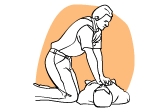
Electricity can be very dangerous when things go wrong. Find out what you should do when you have an emergency that involves electricity.

Electrical emergencies cover things like fire, electrocution, burns – that covers some important nasties. Let’s deal with fire first.
How to deal with electrical fires
The scenario is that you discover charring or worse near a light fitting. Should you throw a bucket of water at that spot of the ceiling? Absolutely not!
It’s one thing to be in a situation where you are sure electricity is not connected or where the fire is evidently far away from wiring or electrical appliances, but unless you are absolutely sure of this you should never douse or attempt to douse the fire with electrically conducting fluids – like water.
If the fire or charring happens at night, switch off all power at the main switch and use a battery-powered torch to guide you. It’s a good idea to have one handy, to ensure that it always has batteries, and to ensure that everyone knows where it is.
The danger with the combination of fire and electricity is that charring (for example, charring of cable insulation) makes for conductive paths. Things go from bad to worse as a short circuit could start and you may not be able to rely on circuit breakers interrupting the circuit. A fire in the roof is really bad news as mostly the spine of your electrical cabling runs in the roof and fire spreads very effectively.
Fire extinguishers for electrical fires
Electrical fires are best handled by the following types of fire extinguishers:
- Carbon dioxide
- Sodium/Potassium bicarbonate
- Ammonium phosphate
Carbon dioxide based fire extinguishers are specially made for electrical and are widely available. Electrical fires are classified as Class E fires, but in many cases, there could also be Class B fires which include flammable liquids like oil (think of kitchen fires). A fire extinguisher for class BE fires is therefore a very handy thing, particularly in the kitchen.
Medical help after electrocution
You discover someone clenched to an electrical appliance – should you pull them away?? No!!! Switch off power at the socket or yank the appliance cord free. Tetanus, the cramping of muscles is common in electric shock – and does not mean the victim is dead or close to death. Have a bystander dial 000 and apply emergency routines:
- Place victim on his/her back
- Tilt head back and raise chin
If there’s no evidence of normal breathing, apply CPR, as follows:
- Depress the person’s chest 4 to 5 cms, give thirty chest compressions (at the rate of 100 per minute – roughly 3.6 seconds between compressions) followed by two breaths.
- Repeat this until normal breathing returns and monitor the victim constantly until medical help arrives.





